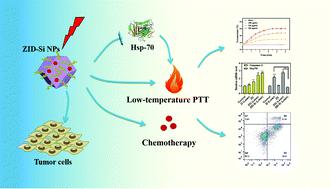当前位置:
X-MOL 学术
›
Biomater. Sci.
›
论文详情
Our official English website, www.x-mol.net, welcomes your
feedback! (Note: you will need to create a separate account there.)
A NIR-triggered multifunctional nanoplatform mediated by Hsp70 siRNA for chemo-hypothermal photothermal synergistic therapy
Biomaterials Science ( IF 5.8 ) Pub Date : 2021-08-05 , DOI: 10.1039/d1bm01006a Bo Zhang 1 , Chen-Wen Shao 1 , Kang-Min Zhou 1 , Qin Li 1 , Yong-Tao Duan 2 , Yu-Shun Yang 1 , Hai-Liang Zhu 1
Biomaterials Science ( IF 5.8 ) Pub Date : 2021-08-05 , DOI: 10.1039/d1bm01006a Bo Zhang 1 , Chen-Wen Shao 1 , Kang-Min Zhou 1 , Qin Li 1 , Yong-Tao Duan 2 , Yu-Shun Yang 1 , Hai-Liang Zhu 1
Affiliation

|
Recently, hypothermal photothermal therapy (HPTT) seemed essential for the future clinical transformation of cancer optical therapies. However, at a lower working temperature, heat shock proteins (HSPs) seriously affect the anti-tumor effect of HPTT. This work reports a reasonable design of a dual-responsive nanoplatform for the synergistic treatment of chemotherapy and HPTT. We adopted a one-step method to wrap indocyanine green (ICG) into imidazole skeleton-8 (ZIF-8) and further loaded it with the chemotherapy drug doxorubicin (DOX). Furthermore, we introduced Hsp-70 siRNA to block the affection of HSPs at an upstream node, thereby avoiding the side effects of traditional heat shock protein inhibitors. The prepared ZIF-8@ICG@DOX@siRNA nanoparticles (ZID-Si NPs) could significantly improve the stability of siRNA to effectively down-regulate the expression of HSP70 protein during the photothermal therapy, thus realizing the pH-controlled and NIR-triggered release of the chemotherapeutical drug DOX. Moreover, tumors were also imaged accurately by ICG wrapped in ZID-Si nanoparticles. After the evaluation of the in vitro and in vivo photothermal effect as well as the anti-tumor activity, we found that the added Hsp-70 siRNA enhanced the synergistic anti-cancer activity of HPTT and chemotherapy. In summary, this work holds great potential in cancer treatment, and suggests better efficacy of synergistic chemo/HPTT than the single-agent therapy.
中文翻译:

由 Hsp70 siRNA 介导的 NIR 触发多功能纳米平台用于化学低温光热协同治疗
最近,低温光热疗法(HPTT)似乎对未来癌症光学疗法的临床转化至关重要。然而,在较低的工作温度下,热休克蛋白(HSPs)严重影响了HPTT的抗肿瘤作用。这项工作报告了一种用于化学疗法和 HPTT 协同治疗的双响应纳米平台的合理设计。我们采用一步法将吲哚菁绿 (ICG) 包裹到咪唑骨架 8 (ZIF-8) 中,并进一步加载化疗药物阿霉素 (DOX)。此外,我们在上游节点引入了 Hsp-70 siRNA 来阻断 HSP 的影响,从而避免了传统热休克蛋白抑制剂的副作用。制备的 ZIF-8@ICG@DOX@siRNA 纳米颗粒(ZID-Si NPs)可以显着提高 siRNA 的稳定性,在光热治疗过程中有效下调 HSP70 蛋白的表达,从而实现 pH 控制和 NIR 触发化疗药物 DOX 的释放。此外,包裹在 ZID-Si 纳米颗粒中的 ICG 也能准确地对肿瘤进行成像。经评估后体外和体内光热效应以及抗肿瘤活性,我们发现添加的 Hsp-70 siRNA 增强了 HPTT 和化疗的协同抗癌活性。总之,这项工作在癌症治疗中具有巨大潜力,并且表明协同化疗/HPTT 比单药治疗具有更好的疗效。
更新日期:2021-08-20
中文翻译:

由 Hsp70 siRNA 介导的 NIR 触发多功能纳米平台用于化学低温光热协同治疗
最近,低温光热疗法(HPTT)似乎对未来癌症光学疗法的临床转化至关重要。然而,在较低的工作温度下,热休克蛋白(HSPs)严重影响了HPTT的抗肿瘤作用。这项工作报告了一种用于化学疗法和 HPTT 协同治疗的双响应纳米平台的合理设计。我们采用一步法将吲哚菁绿 (ICG) 包裹到咪唑骨架 8 (ZIF-8) 中,并进一步加载化疗药物阿霉素 (DOX)。此外,我们在上游节点引入了 Hsp-70 siRNA 来阻断 HSP 的影响,从而避免了传统热休克蛋白抑制剂的副作用。制备的 ZIF-8@ICG@DOX@siRNA 纳米颗粒(ZID-Si NPs)可以显着提高 siRNA 的稳定性,在光热治疗过程中有效下调 HSP70 蛋白的表达,从而实现 pH 控制和 NIR 触发化疗药物 DOX 的释放。此外,包裹在 ZID-Si 纳米颗粒中的 ICG 也能准确地对肿瘤进行成像。经评估后体外和体内光热效应以及抗肿瘤活性,我们发现添加的 Hsp-70 siRNA 增强了 HPTT 和化疗的协同抗癌活性。总之,这项工作在癌症治疗中具有巨大潜力,并且表明协同化疗/HPTT 比单药治疗具有更好的疗效。











































 京公网安备 11010802027423号
京公网安备 11010802027423号